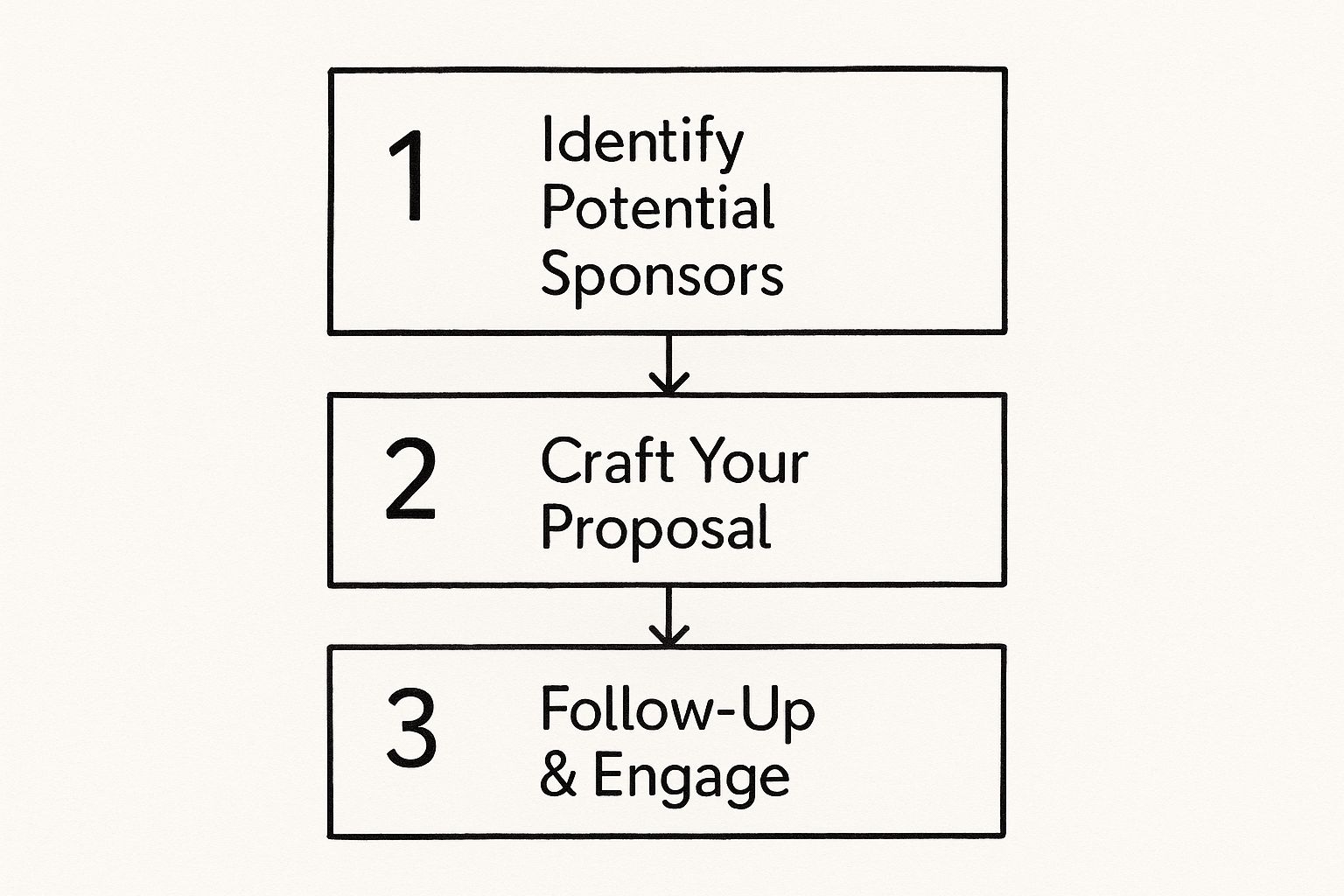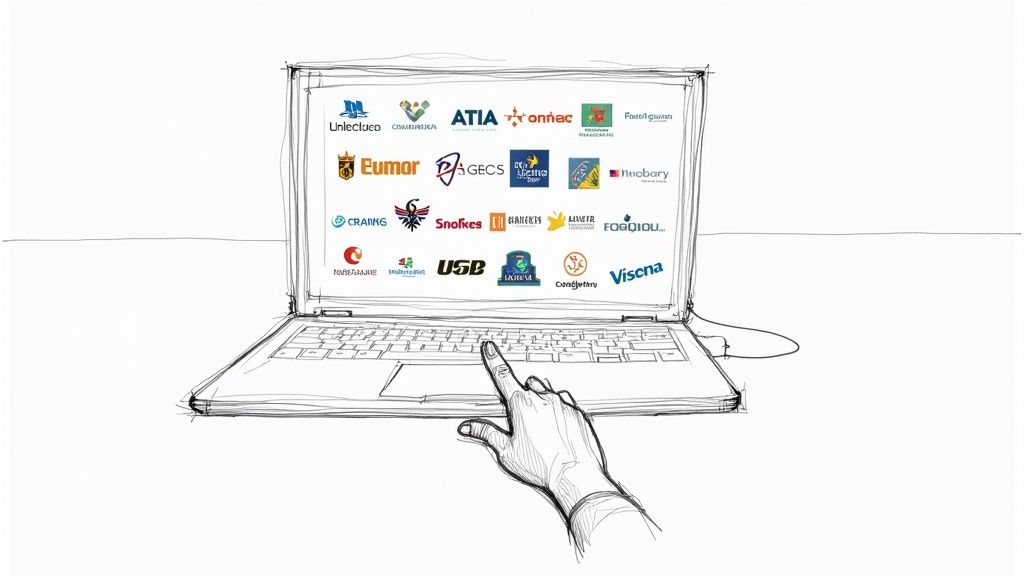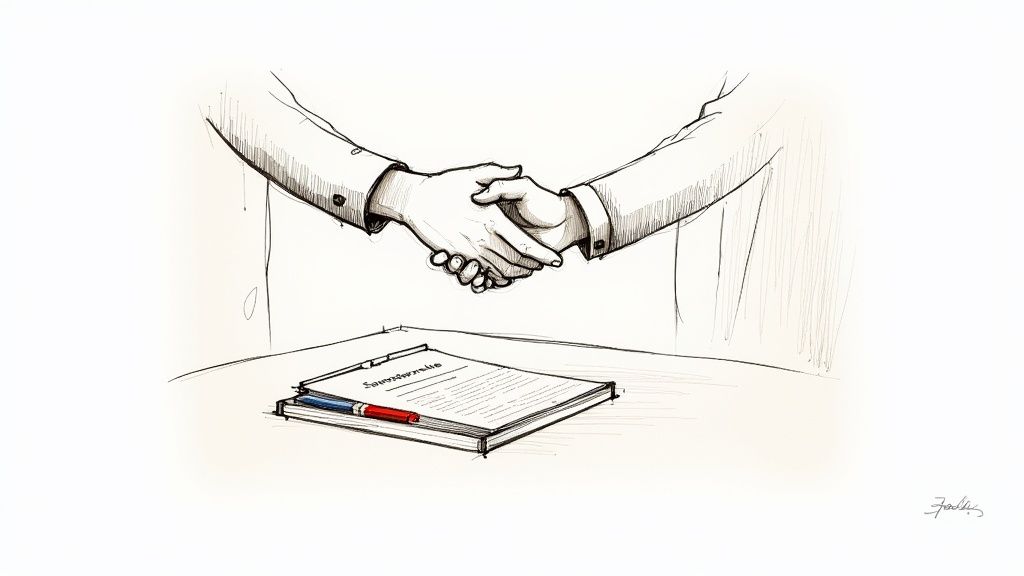October 8, 2025

Securing a sponsorship doesn't start with an email. It starts with a solid game plan. The real secret is to build a strong foundation long before you reach out, by getting crystal clear on your own value, finding brands that are a natural fit, and putting together a case that makes saying "yes" a no-brainer.
Before you even dream of writing that proposal, the real work has to happen. This is where you move past wishful thinking and get strategic, and it's what separates a "yes" from a "no-reply." It means taking an honest look at what you’ve got—your audience, your reach, and the unique story you can offer a partner.
Think of this stage less as asking for money and more as building a bulletproof business case.
First thing's first: you need to know exactly what you're offering. Sponsors are looking for a return on their investment, whether that’s brand exposure, new leads, or just good old-fashioned community goodwill. You need to give them hard numbers, not just vague promises.
It's tempting to just make a list of companies with deep pockets, but that’s a rookie mistake. The best partnerships come from shared values and goals. Do your homework and find companies whose mission and marketing objectives genuinely align with yours. For a wider view on this, you can explore the various aspects of sponsorships to see how different industries make it work.
This infographic lays out the basic playbook.

As you can see, it boils down to three key pillars: finding the right sponsors, crafting a killer proposal, and being persistent with your follow-up.
Vague requests get vague (or no) answers. Your best bet is to create tiered sponsorship packages with clear, distinct benefits. This makes it incredibly simple for a busy marketing manager to see the value at each level and pick an option that fits their budget. For a deeper dive, check out our guide on how to https://groupos.com/blog/find-sponsors-for-events.
The competition for these partnerships is heating up. Global brands dropped a staggering $97.4 billion on sponsorships back in 2022. That number is expected to explode to $189.5 billion by 2030, which just goes to show how crucial a well-thought-out strategy really is.
The biggest mistake you can make is focusing on what you need. Instead, you must obsess over what a sponsor gets. Frame every benefit in terms of their goals, not yours.
Here's a sample of what tiered packages could look like. It's a simple way to show sponsors exactly what they get for their money at different levels.
Use this structure to build your own packages, showing clear value progression at each investment level. This approach makes it easy for potential sponsors to find the perfect fit and justify the spend internally.
Think of your sponsorship proposal as your representative in a room you're not in. It has to do all the talking for you. This is where you move past generic templates and tell a compelling story that connects what you do with a brand's specific marketing goals. The secret is to shift the focus from what you need to what they get.

Your proposal needs to be a professional, passionate, and persuasive document. It’s the bridge connecting a sponsor to their next wave of loyal customers—your audience. Your job is to make a partnership feel like a smart, strategic investment, not just a charitable donation.
Decision-makers are swamped. The last thing they want to see is a wall of text. The best proposals are easy to scan and look great. Use clean design, punchy headlines, and enough white space to guide their eyes straight to the most important info.
Think of your proposal as telling a short story:
A truly great proposal anticipates and answers questions before they're even asked. It needs to spell out the ROI for the sponsor—whether that's generating leads, boosting brand awareness, or building positive community sentiment. Leave them with zero doubt about what’s in it for them.
To make your proposal truly pop, you need to back up your story with hard data. Marketers are driven by numbers, so use them to build a rock-solid case for the value you deliver. For a fantastic real-world example, check out this well-crafted sample sponsorship proposal to see how it all comes together.
Make sure your pitch deck includes these non-negotiable elements:
Once your sponsorship proposal is polished, the real work begins. Sending it off is just the first step. Now, you have to lean into the human side of things, where a great email and a confident conversation can seal the deal. This is the moment where all your careful research and planning pay off.

Let's be honest: everyone’s inbox is a battlefield. To win, you need a personal touch. Generic, copy-and-paste emails stick out like a sore thumb and are usually deleted on sight. Your mission is to start a real conversation about how you can grow together, and that starts with the very first sentence.
Your first email has to be short, personal, and all about them. Forget long introductions about yourself or your organization. Instead, open with something that shows you've actually been paying attention to their brand.
A strong opening could mention a recent campaign they ran or a company value that really resonates with your own mission. It’s an instant signal that you’re not just another random request. Craft a subject line that is both intriguing and clear. Something like "Partnership Idea for [Company Name]'s Community Initiative" will get a much better response than a bland "Sponsorship Opportunity."
In the body of the email, you need to accomplish three things quickly:
When you get that meeting, be ready to state your case clearly and with passion. Have a 30-second "elevator pitch" down cold. You need to be able to nail the who, what, and why of your proposal, always tying it back to what's in it for them—their potential return on investment.
But here's a pro tip: once you're in the conversation, listen more than you talk. Ask smart, open-ended questions to dig into their current marketing goals and pain points.
Try asking things like:
This simple shift turns your pitch into a collaborative discussion. It shows them you're thinking like a partner, not just asking for a check. For more on mastering this part of the process, our guide on how to obtain sponsorships from corporations offers some great in-depth strategies.
Persistence is key, but it has to be professional. If you don't get a reply to your first email, a polite and friendly follow-up a week later is not only acceptable—it's often what it takes to get noticed.
It's almost unheard of for a sponsor to sign on without asking some tough questions. Don't get defensive. Treat their objections as a good thing—it means they’re engaged and just need more information to feel confident. Most objections come down to budget, timing, or audience alignment.
This is where your preparation shines. Have your data ready. If they question whether your audience is right for them, be ready with your demographic reports and engagement stats. Coming to the table prepared like this demonstrates that you're a serious, professional partner and can turn their hesitation into a yes.
Congratulations, you got the "yes"! It's a great feeling, but here's a crucial piece of advice I've learned over the years: this isn't the finish line. It's the starting line. Too many people get the signed contract, breathe a sigh of relief, and immediately shift focus. But that's a huge mistake. Securing the sponsorship is where the real work of building a valuable partnership truly begins.

How you act in the moments immediately following the agreement sets the tone for everything to come. A prompt, genuine thank-you note—and I mean a separate one, not just a line on the invoice—is a small gesture that has a massive impact. It immediately shows you're appreciative and professional, reinforcing their decision to invest in you.
The absolute bedrock of a strong partnership is delivering on every single thing you promised in your proposal. This isn't just about ticking boxes; it's about executing flawlessly and looking for opportunities to go the extra mile. Your best friend in this phase is meticulous organization.
I always create a master checklist or a simple project plan that maps out every single deliverable. It might look something like this:
This level of detail is a key part of successfully navigating brand relationships. Your goal is to make the entire process completely seamless for their marketing team.
Don't ever make your sponsor chase you for an update. Be proactive. Send them quick, positive progress reports. Share a screenshot of a social media shout-out that's getting great engagement. Give them a sneak peek of the event signage. These little updates show you're on top of everything and that you value their investment.
Then, think beyond the contract. Look for small, unexpected ways to add a little extra value. Did you happen to mention them in a podcast interview? Send them the audio clip. Did a fantastic photo from your event prominently feature their brand? Share it with them and let them know they're welcome to use it. These gestures make a huge difference.
The goal is to make your sponsor feel like a celebrated partner, not just another line item on their marketing budget. When they feel seen and valued, they are far more likely to renew and even increase their investment next time.
Sponsor retention is one of the most important metrics for long-term success. Think about it this way: nonprofits see an average donor retention rate of about 45%, but that number plummets to just 20% for first-time donors. The magic happens after that second contribution—the likelihood of them continuing to give jumps to 60%. The same principle applies here.
Your job is to lay the groundwork for renewal months before the current contract is even up. By providing a fantastic experience, delivering concrete results, and keeping the relationship positive, the conversation about next year becomes a natural, easy next step. If you're juggling multiple sponsors, you'll also want to think strategically about how to structure your offerings in different event sponsorship packages to make renewal an even more attractive option.
Navigating the world of sponsorships means understanding that a brilliant idea just isn't enough on its own. Even the most incredible proposals can get lost in the shuffle if they fall into a few common traps. Let's walk through the missteps that get emails sent straight to the trash folder so your pitch can stand out for all the right reasons.
The single most damaging mistake is blasting out a generic, one-size-fits-all proposal. An email that opens with "To Whom It May Concern" is a dead giveaway that you haven't done your homework. Brands get dozens of these every week, and they’re the first to go.
Personalization is absolutely non-negotiable. It shows you respect their brand enough to understand who they are, what they actually care about, and who the right person to talk to is. Simply taking the time to find the marketing director's name and mentioning a recent campaign they launched can be the difference between getting a reply and being ignored.
Another huge error I see all the time is failing to connect your opportunity to a sponsor's real-world marketing objectives. You might have an amazing event planned, but if you can't clearly explain how it helps them sell more widgets, reach a new demographic, or build brand loyalty, your proposal is going nowhere.
You have to start thinking like a marketer. Stop focusing on what you need from them and start obsessing over what they get out of the partnership.
This is exactly why that initial research phase is so critical. A proposal that shows you truly understand a company's goals feels less like you're asking for a handout and more like you're presenting a genuine business opportunity.
Your proposal's job is to solve a problem for the sponsor's marketing team. Frame your ask as the solution to their challenge of reaching a specific, valuable community—yours.
So you've sent a fantastic, personalized proposal. You wait. A week goes by, then two. What do you do? Too many people do nothing, worried they'll come across as pushy. This silence is often the final mistake that sinks a great opportunity.
Decision-makers are busy people. Their inboxes are a war zone. A polite, professional follow-up isn't an annoyance; it’s a necessary part of the process. A simple, friendly email a week after your initial pitch can pop your proposal right back to the top of their list.
If you still don't hear back after a second follow-up a week later, it's probably time to move on. But abandoning the effort after just one attempt is leaving potential partnerships on the table. A thoughtful follow-up strategy shows you’re persistent and professional—qualities any brand would want in a partner.
Let's be honest, chasing sponsorships can feel like you're trying to crack a code. You've got a killer idea and the perfect partner in mind, but getting them on board is the tricky part. I get these same questions all the time, so let's clear them up and get you moving forward.
Getting these fundamentals right will save you a ton of headaches and help you walk into those conversations looking like a pro who has their act together.
Timing can make or break your entire effort. When you're approaching major corporate sponsors, you need to be thinking 6 to 12 months ahead. I know that sounds like a lifetime, but big companies often lock in their marketing and sponsorship budgets a full year in advance. If you show up late to the party, the money's already gone. Getting on their radar early shows you're a serious planner.
Now, if you're talking to smaller, local businesses, you have a bit more wiggle room. A 3 to 6-month lead time is often perfect. But whatever you do, avoid the last-minute ask. It screams poor planning and almost guarantees you won't be taken seriously.
First off, don't take it personally. A "no" is just part of the game. How you react, though, is what really matters.
Always—and I mean always—reply with a short, professional email thanking them for their time and consideration. It’s a simple gesture, but it keeps the door open and shows you're a class act.
If you had a genuinely good rapport, it's perfectly fine to ask for a little feedback. Something like, "I appreciate you taking a look. If you have a moment, I'd be grateful for any feedback on our proposal for future reference." A "no" today isn't always a "no" forever. Every rejection is just a chance to get better for the next one.
Not only is it okay, but it's essential. People are busy. Inboxes are a nightmare. Your email probably just got buried. Don’t assume silence is a rejection.
My rule of thumb is to wait about a week after sending the proposal. Then, send a short, friendly nudge.
Here's a simple script: "Just wanted to briefly follow up on the sponsorship proposal I sent last week and see if you had any initial questions."
It's helpful, not pushy. If you still hear crickets after that, one more follow-up a week later is fine. After two attempts with no reply? It's probably time to move on and put your energy into prospects who are actually engaging.
Yes, absolutely. Don't be vague. Asking for an open-ended donation is one of the most common rookie mistakes. It puts all the work on the sponsor to figure out what you want and what they get.
Instead, present them with clear, tiered sponsorship packages—think Gold, Silver, and Bronze levels. Each tier should have a specific price and a list of concrete benefits. This approach makes it incredibly easy for them to see where they fit, what they get for their money, and how it aligns with their marketing goals. You're not just asking for cash; you're offering a strategic partnership with clear value.
Juggling sponsors, engaging members, and running events can get chaotic fast. GroupOS is an all-in-one platform built to streamline everything. You can manage ticketing, memberships, and even give your sponsors their own dedicated profiles with analytics.


